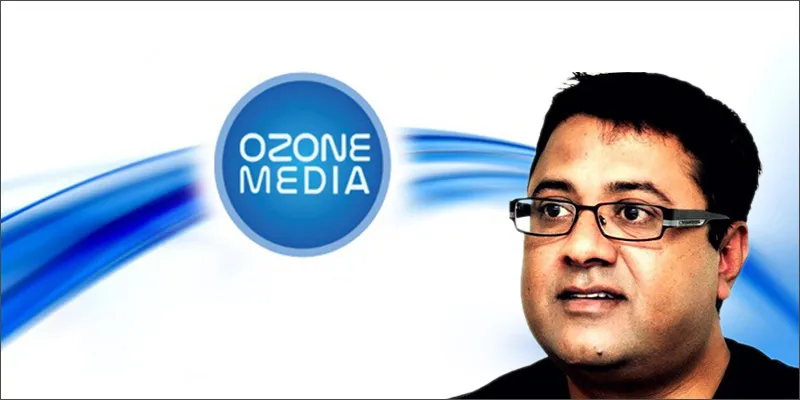IDG funded ad tech firm Ozone Media looks to cross $100 million by 2016
Kiran Gopinath toyed with an idea of an online advertising platform for about two years before he took the plunge. He quizzed potential customers, looked at the global digital landscape, spoke to the founders of some of the largest ad networks in the US, and clearly saw "the opportunity of being the first Indian ad network" before he started Ozone Media in February 2006. He was the single-member team then. The headcount grew to 2 in a month, and in a year, they were 6 and had already turned profitable.
One of the pioneers of the internet advertising industry in India, Kiran got into the space as early as 1997. He cofounded his first venture capital-funded company called Webshastra in 2000, which saw the dot com bubble era. Post that, he started working on technologies that enable advertising to cross over from traditional media to digital media, and started Ozone Media to meet that need.

Ozone Media was mostly bootstrapped, with "some help from some terrific guys and thank goodness for that," the founder & CEO tell us. "The first was B G Mahesh who took a punt very early on in May of 2006, wrote out a cheque to me and joined the board on the formation of the company. The second was Sanjay Anandaram who also just wrote out a cheque within a few months of my starting Ozone Media, in November of 2006. Whenever I think of where it all began these are the first guys who come to my mind, as without their help I would have found it difficult to pay salaries the following month. They wrote out cheques to me without asking any questions about when and how I would return the same," Kiran adds.
This was followed up by their first round of funding by IDG Ventures, a leading India-focused US$150 million technology venture capital fund.
According to Magna Global, programmatic spending, globally, will reach $33 Billion USD by 2017 and Forester Research suggests average CPM prices will increase from $3.17 to $6.64. "This is the space we are operating in. Hence, it’s increasingly obvious that programmatic is the way forward," Kiran says.
Recently, Ozone Media transitioned from being just an ad-network to a more product-focused company with greater synergies with ad-platforms.A couple of months ago, they expanded operations to the Silicon Valley.
The need for quick pivotal points
The digital landscape is nothing if not dynamic. It’s a place for quick movers and innovators. Kiran was quick to spot the trends and pivot. Particularly in two cases:
1. The digital landscape was changing. The role of the ad networks was diminishing because of democratisation of inventory access through exchanges and DSPs, SSPs etc.
2. "We were facing a huge cash flow issue in India, where advertisers don’t pay as per their billing cycle and sometimes for as long as 120 days, and we had to bank role them and pay the publishers. Publisher payments were getting delayed as a consequence and this did not leave any of us happier."
Picking up the cues that the market was giving us, we decided to focus more on scaling up in other markets like the US, EMEA where margins are better and pay-outs are timely. This helped us increase revenues and shut the India focussed network business completely," Kiran says.
Currently, an active speaker at various digital marketing forums and discussions, including IAMAI, MMA and ad tech, Kiran had entered into partnerships with reputed publishers early on. Ozone Media's clientele includes CitiBank, PolicyBazaar, MakeMyTrip, Koovs, Myntra, Medplus, Jeevansathi, BharatMatrimony, Audi, Ford, Naukri.com, ICICI, Yahoo!, Dell, Lenovo, Cleartrip, Nokia, Britannia, and Huggies among others.
Aggressive pricing
From being an ad network focussed in India, Ozone Media moved to being a global ad tech product and technology company. "Our products are targeted mainly at the middle market globally and have been priced aggressively to meet the needs of this target group. These products are highly customizable and are continuously evolving. We aim to empower the users with technology, which helps them to get more out of the existing resources. At the same time, we want to ensure that user experiences the “ease of use” with our products," Kiran says.
While keeping pace with the technology, it is also important to "keep things simple", according to him. "Our business has become cash flow positive by solving the problems faced by the middle segment of the market we are in."
He says that they are looking at crossing "$100 million by 2016 while being profitable".
There are a few tips Kiran follows religiously:
1. Never assume anything
2. Never hesitate to seek help and ask questions
3. Be prepared to take a no for an answer.
As an entrepreneur, he believes that all these are a part of the journey and one has to learn to deal with it.
What are your success mantras? Tell us in the comments below.







